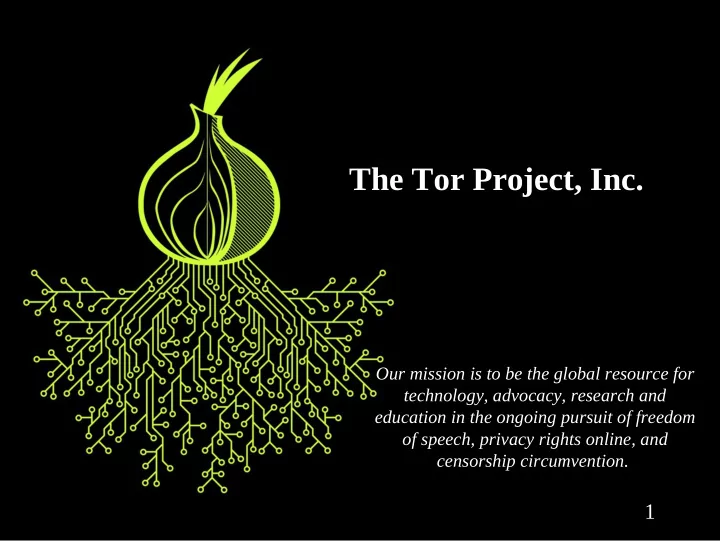

The Tor Project, Inc. Our mission is to be the global resource for technology, advocacy, research and education in the ongoing pursuit of freedom of speech, privacy rights online, and censorship circumvention. 1
2
3
4
5
6
7
8
When we wrote the SAFER proposal ● Iran ran default-config Smartfilter ● China had blocked public Tor relays; vanilla bridges worked great there ● China did stateless regexp on TCP payload ● Tor was blending with SSL, because “who would block SSL” ● Before Tunisia, Egypt, Libya, Syria, ... 9
10
11
Tor Controller Interface ● stem ● pytorctl ● jtorctl ● txtorcon 12
Tor network simulators ● Shadow ● ExperimenTor ● Chutney ● Puppetor 13
14
compass.torproject.org 15
Orbot 16
Tails LiveCD 17
Pluggable transports 18
19
“Fronting” ● Google ● Amazon S3 ● Cloudflare ● Akamai 20
Obfs4 ● Obfs3 used UniformDH, CTR-AES256, HMAC-SHA256 ● Obfs4 uses Curve25519, Elligator2, HMAC-SHA256, XSalsa20/Poly1305, Siphash ● Go, C++, Python implementations (so all the Orbot users in Turkey can use it) 21
uProxy ● Google + UW collaboration ● Discovery: Google Plus contacts – But only one hop away (abuse) ● Transport: WebRTC (udp + sctp) 22
Composing and layering Transport App (Tor) Transform 23
Composing and layering Transport App (Tor) Transform Transform App (uProxy) Transport 24
Composing and layering Transport App (Tor) Transform Transform App (uProxy) Transport 25
26
Two paradigms ● “Look like nothing” ● “Look like something they expect” ● Active probing: what should your service look like if the client doesn't auth right? ● “Be not there” vs “Be innocent service” 27
Criteria for judging Pts (1) How reviewed / reviewable is it? ● 1) Is the software published? Is it entirely free / open source? (Skype, Windows) ● 2) Published design doc, w/ threat model? Spec? How much peer review? ● 3) What is its deployment history? Past publicity, number of users, etc. 28
Criteria for judging Pts (2) Evaluation of design ● 4) How difficult/expensive will it be to block (by protocol, by endpoints, etc) ● 5) What anonymity impacts does it have? ● 6) What's the bandwidth overhead? ● 7) How does it fare against active probing? 29
Criteria for judging Pts (3) Evaluation of implementation ● 8) Does it use Tor's PT API already? ● 9) Cross-platform, including mobile? ● 10) How easy is the build process? Includes dependencies, deployment scale ● 11) Is the code secure and maintainable? 30
Measurement Lab / Adversary Lab ● We need a set of benchmarks (“Iran 2011”) to test against – real attacks that we want to know how a given design fares against ● Background traffic issue ● Assessment needs to describe attributes, not conclusions. “China can't block this” vs “An adversary who does X would choose not to block this” 31
Measurement Framework Need to extend the framework to include: ● Probing / active attacks – We need probe vectors! Skype connections, web connections, Tor connections, etc ● Pass traffic through transparent proxies 32
OONI: Measuring interference in the wild ● Measuring censorship of destinations and protocols ● But just as importantly, preemptively tracking which protocols work where 33
Discovering blocking rules ● Imagine you have a trace that gets blocked, and a trace that doesn't get blocked ● And you can generate new traces and I'll classify them for you ● “Active learning” from ML literature 34
Techniques to slow down learning: take the feedback out of the loop ● China only samples traffic during periods of high load, so it misses some ● Censorship triggers a ten minute black hole ● DPI triggers active probing later ● Throttling makes classification fuzzy ● Is your vantage point representative? 35
Other outstanding issues: GetTor ● How to fetch Tor browser if torproject.org is blocked? ● Easy, but: how do you verify the signature? ● Easy, but: how do you download gnupg? ● Satori uses browser extension to check sigs, https github/S3/etc to fetch software 36
Three ways to destroy Tor ● 1) Legal / policy attacks ● 2) Make ISPs hate hosting exit relays ● 3) Make services hate Tor connections – Yelp, Wikipedia, Google, Skype, … ● #3 is getting worse due to centralization (Akamai, Cloudflare) and to outsourcing blacklists 37
Anonymity analysis ● The Internet is more centralized than we'd like ● Guard churn issue is huge ● Website fingerprinting not such a big deal due to false positives at scale? ● Application-level security still key 38
“Still the King of high secure, low latency Internet Anonymity” Contenders for the throne: ● None 39
Recommend
More recommend